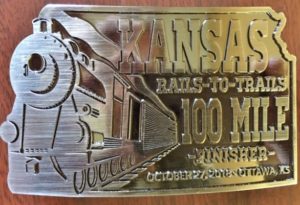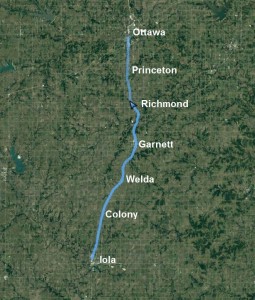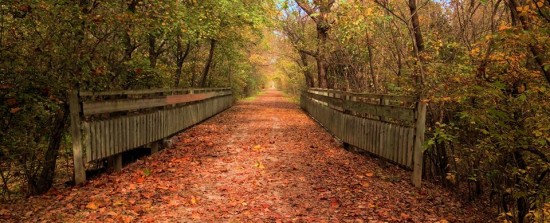I was privileged to run the Kansas Rails-To-Trails 100 held in eastern Kansas, part of the Kansas Rails-to-Trails Fall Ultra Extravaganza. I ran this race back in 2017, enjoyed the long flat course and was eager to return. It runs on a former rail bed, the 51-mile Prairie Spirit Trail.
 But the background story was a long and frustrating one. In February at about mile 65 of Rocky Raccoon 100 in Texas, I felt some unusual sharp injury pain in my left knee and knew that I needed to stop, so I wisely did. After doctors’ visits, the knee was scoped, cleaned out, with no significant problem other than a lot of wear. Five weeks later I started running again but after one long run I came up very lame. I stopped running altogether for months after a second MRI and other treatments. To try to stay in some sort of shape, I started swimming again, which I disliked, and then did a few 80-mile bike rides on a mountain bike which I enjoyed. But it still wasn’t running.
But the background story was a long and frustrating one. In February at about mile 65 of Rocky Raccoon 100 in Texas, I felt some unusual sharp injury pain in my left knee and knew that I needed to stop, so I wisely did. After doctors’ visits, the knee was scoped, cleaned out, with no significant problem other than a lot of wear. Five weeks later I started running again but after one long run I came up very lame. I stopped running altogether for months after a second MRI and other treatments. To try to stay in some sort of shape, I started swimming again, which I disliked, and then did a few 80-mile bike rides on a mountain bike which I enjoyed. But it still wasn’t running.
In September, with little improvement, my doctor looked closer at the last MRI and said that I had an insufficiency fracture on both my femur and tibia. I was scheduled for a second surgery to fill in the insufficient bone surface areas. But I finally saw improvement and opted to skip the surgery. It would have involved two weeks on crutches and starting the recovery over again.
Improvement continued, so I started running a little. I decided to try running the St. George Marathon which I had signed up for months before. I had only two weeks to try to get into some sort of running shape. I had a wonderful time in St George and finished with a surprising time of 4:09 after sitting on the couch for seven months.
Improvement continued. After just one more long run, I got the crazy idea to sign up for the Kansas Rail-To-Trail 100 in two more weeks. I didn’t have any time to train because during that time I put on my Pony Express Trail 50 and 100, but I hoped for the best. I would attempt to finish my #98th 100-mile with only three weeks of training in the past eight months. I tried not to think how crazy that was but I believed that once your body experiences a high mileage base, that it can still perform well, even with a long layoff. So I flew to Kansas.
In 1867 construction began of a 143-mile rail line running north/south through eastern Kansas and was completed in 1871 connecting a number of small towns. The rail line was active until 1990 when it was abandoned after being sold. The Kansas Department of Wildlife and Parks was granted title in 1992 for a recreational trail. By 2008, an amazing 51-mile stretch of the trail had been developed and named the Prairie Spirit Trail.
The Prairie Spirit trail is a combination of paved trail through the towns and smooth hard-packed crushed limestone as it goes across the prairie. The trail is maintained very well, is free of rocks, and averages eight feet wide. It is very flat with no perceived hills. The 100-mile course runs nearly the length of the trail, an out-and-back from Ottawa to Iola and back, and climbs only about 1,000 feet and the climbing is barely noticeable.
There were only about 35 100-miler runners starting, but at the same time there were more runners going 100K and 50-mile as well. We all started at 6:00 a.m. It was exciting to again be running in a 100-miler but I was very nervous about what could happen during the hours to come. The knee did quickly complain but I knew the pain would calm down.
Once away from the town of Ottawa, the eastern sky started to light up with a brilliant smoky colored sunrise. We would run through a tunnel of fall trees for long stretches. The really interesting views appeared when we neared and went through the towns. The amazing smooth trail would cross remote rural roads along the way letting us see the surrounding farms.
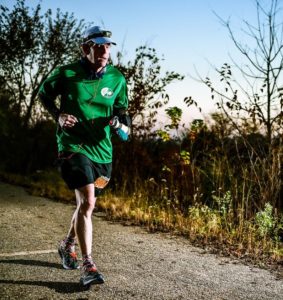
My pace for the first nine miles to the town of Princeton was solid, about 9:30-mile pace. By mile 15 at Richmond I finally felt warmed up and the knee felt generally fine. I felt optimistic. I followed for miles three ladies who had a very solid constant pace. I eventually caught up to them around mile 20. One lady knew right away who I was, called me by name, and introduced me to her friends. We had some fun conversations for several miles. They were all from Colorado and were running the 100k and were really nice and encouraging.
I hit the marathon mark at about 4:45, about a half hour slower than last year. My time really wasn’t important to me, I just wanted to somehow finish this race before the 30-hour cutoff without injury. As the afternoon arrived, it became quite warm into the 70s. I certainly had no recent training running in the heat, so it very quickly affected my stomach. At mile 41, in Colony, I rested for about ten minutes and tried to recover. I was at 8:35 into my run, nearly 90 minutes slower than last year. All was going generally fine.
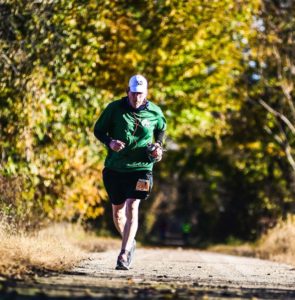
The late afternoon started cooling off by the time I reached 50 miles in a relatively slow 10:50 compared to 9:22 last year. But I was on a great target to finish.
At about mile 55, discouragement arrived. I had some significant pain in both knees and started to limp badly. What was I going to do? I certainly could not just limp slowly for 45 more miles. That would be terrible. I sat down by the trail to think things through. A song came on my headphones that told me “get myself up off the ground.” So I did. I got going again and tried harder to alter my foot placement and stride, hoping that it would help and it did. In about a mile later, I again was running strongly relatively pain-free.
Dusk arrived, the air cooled down and I was in very high spirits once I returned to Colony at mile 68.6 at 14:11 (8:11 p.m.). I joked around with the volunteers there. The previous year I had reached this point at 11:49. Yes, I tried to run faster, but my main issue was due to lack of training. My muscles were sore and I didn’t want to risk pulling one of them so I was careful. During the long night, I kept up a constant pace, trying to keep my miles faster than 15 minutes, but they were slower.
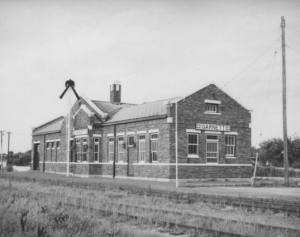
I was thrilled to reach the “only a marathon left” point. I became convinced that I could pull this off. I returned to Garnett, mile 77 at 19:18, nearly three hours slower than last year. I knew I was now far back in the standings. They told me there were about seven runners still behind. At the aid stations I would see a few sad runners in blankets who looked like they were giving up. It was pretty lonely out running on the moon-lit trail. I sang to songs to stay alert and keep my mind on things other than pain. I was usually all alone with no lights seen in either direction. A lady runner would pass me now and then who somehow ran without a light. I would always catch up because of her long aid station stops. She was getting cold so she constructed a garbage bag skirt to help keep her legs stay warm. I never felt cold.
My goal to the finish was to try to keep my mile times faster than 20-minute miles. The “speed” goal became impossible because I was hit by terrible drowsiness, the worst I had ever experienced during a race. I ended up taking at least eight little cat naps along the side of the railbed. I never truly fell asleep, but each of stops rested my eyes and helped for at least a mile or two. Both my knees were in pain. They were just not used to this long sustained punishment anymore. My hamstrings weren’t happy when I tried to run at ten-minute-mile pace, so I stopped trying to do that.
Dawn arrived with about seven miles to go. I hoped that the light would wake me up but it didn’t. At times the drowsiness was so bad that I would weave back and forth on the rail trail and have to catch myself as I started to walk off the rail bed.
Finally I could hear the noise of the freeway at Ottawa and there was just three more miles to go. The death march for the past 20 miles had been terrible, but I kept focused on reaching the finish and getting that belt buckle. That moment did arrive! People saw me coming, scrambled for cow bells and cameras which made me speed up to a good finishing run. I finished in 28:00:48, more than four hours slower than last year when I was in good shape. Only two runners finished after me. But I didn’t care. I did it! #98 100-mile was in the books with only three weeks of training.
A few months earlier, when I could hardly walk even one mile, I was trying to adjust to the thought that I would never run a 100-miler again. When I talked to people about running, at times I would find myself saying that I “used to be an ultrarunner.” I accepted it. I moved on to do other things, family history, creating websites, starting a podcast, and doing deep research and writing on many aspects of ultrarunning history. But perhaps it isn’t over and I will reach 100 100-milers.
I get asked often when and where my 100th 100-miler will take place. I seriously don’t know. I think it will just happen at the right time. It never was a lifetime goal, it just popped up about three years ago.
How many people have accomplished 100 100-milers. There is no official list and a few of the runners don’t dwell on it. But I believe there has been ten amazing runners who have achieved 100 100+-milers in official races (not counting solo adventure runs). Here is the list in no particular order. Hans-Dieter Weisshaar of Germany, Ed Ettinghausen of California, Dan Brenden of Arizona, Monica Scholz of Canada, Catra Corbett of California, Mike Smith of New Mexico, and Ray Krolewicz of South Carolina. Liz Bauer of South Carolina, John Taylor of Kansas and Susan Donnelly of Tennessee achieved it last year. I have met them all and hope to join their club soon.
Two-day update: Already feeling great with typical fast recovery that I would experience before. All soreness almost gone. Thinking about running plans for the weekend.


